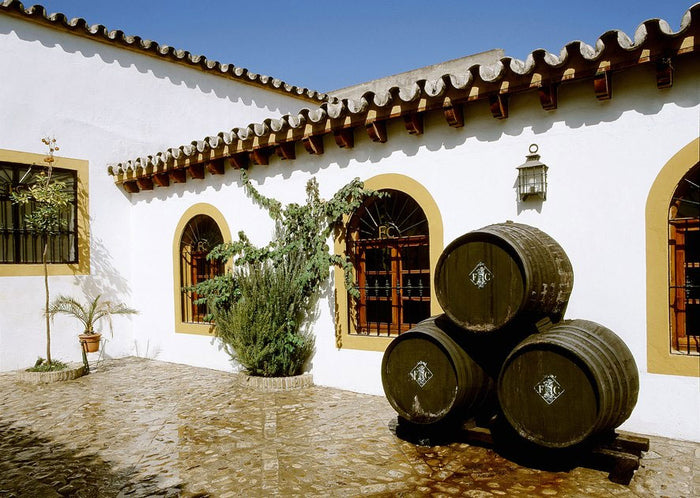Description
For the realization of this method is used Sherry solera.
The solera system (from the Spanish 'suelo') was the mid-1800s when the English importers asked the wineries have a constant quality in taste.
The method is that you can add to the wine previously held in the barrels, the other new wine in order to ensure the continuity of the 'Flor' that might otherwise die if not continually refreshed with new wine.
It then takes no more than one third of wine from the barrels older, while in the fall, will be drawn from the barrels above the same quantity of wine removed until the last barrel above the 'criadera' (pile of barrels of 550l.) which will be filled with new wine.
Pedro Ximenez is the name of the grape used. It 's the more sweet and sumptuous Sherry, of a dark color, almost black, has a scent reminiscent of raisins and dried figs. It goes well with dessert structured even chocolate, sipping wine.
Awards
Details

Perfume

Color

Taste
Serve at:
10 - 12 °C.
Longevity:
10 - 15 years

Pairings
- Start up year: 1972
- Oenologist: Maribel Vergara
Only brandies of the highest categories of the D.O., namely Solera Reserva and Solera Gran Reserva are made. Bodegas Rey Fernando de Castilla is a funding member of the D.O. Brandy de Jerez. The aim of Bodegas Rey Fernando de Castilla has always been to offer the very best products from the sherry district presented in an elegant and contemporary way. Read more


| Name | Fernando de Castilla Sherry PX Pedro Ximenez |
|---|---|
| Type | White green fortified wine dessert wine |
| Denomination | Jerez-Xeres-Sherry DO |
| Size | 0,75 l |
| Alcohol content | 15.0% by volume |
| Grape varieties | 100% Pedro Ximenez |
| Country | Spain |
| Region | Andalusia |
| Vendor | Fernando de Castilla |
| Origin | Jerez de la Frontera. |
| Climate | The climate of Jerez is the hottest in all of Spain. The proximity to the Atlantic Ocean helps with humid winds from the west at night to cool the soil and the vines and the Atlantic breeze is also due to the formation of a precious yeast 'Saccharomyces Beticus' that forming suulla grape skin is responsible for the formation of the 'Flor' yeast protective layer that isolates the wine from contact with the air and give it a special and unique taste. |
| Soil composition | The most important field is called 'Albariza', white chalk and is particularly around San Lucar de Barrameda where they produce the best 'Finos' called 'Manzanilla'. The peculiarity of this ground is to quickly absorb water which rarely falls, immediately after it forms a uniform crostasuperficiale that prevents its evaporation. |
| Fermentation | 8 Days. |
| Production technique | The method called Solera (from the Spanish 'suelo') was the mid 800s when the English importers asked the wineries have a constant quality in taste. The method is that you can add to the wine previously held in the barrels, the other new wine in order to ensure the continuity of the 'Flor' that might otherwise die if not continually refreshed with new wine. It then takes no more than one third of wine from the barrels older, while in the fall, will be drawn from the barrels above the same quantity of wine removed until the last barrel above the 'criadera' (pile of barrels of 550l.) which will be filled with new wine. |
| Wine making | After the harvest is the mashing, then proceed with a rapid fermentation (about 8 days), followed immediately by a malolactic fermentation (degradation of malic acid into lactic acid, which has a pH less acid with simultaneous production of carbon carbon). At this point we proceed with a 'Mutated', ie the addition of a wine distillate at 78%, which blocks all fermentations in place, thanks to the action antiseptic and preservative. (Up: 15 6% alcohol; Oloroso: 17 8% alcohol). During malolactic fermentation will form a layer on the surface of yeast exhausted called flor. At this point the capataz (cellar master) selects the type of sherry in the thickness of the flor and proceed to aging. |
| Residual sugar | 500.0 gr/L |
| Allergens | Contains sulphites |






